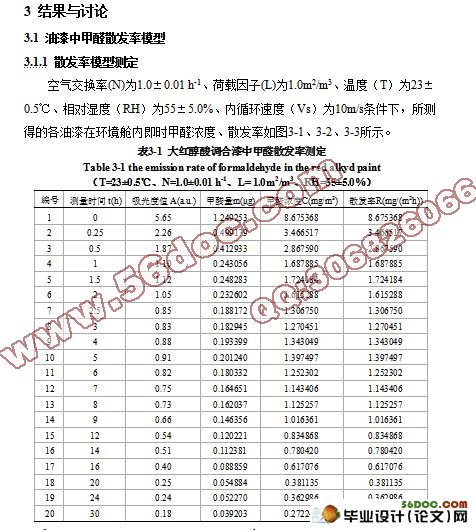室内空气交换率对空气质量的影响(含任务书,开题报告,外文翻译,毕业论文11000字,答辩PPT)
摘 要
近年来室内空气污染越来越受到人们的关注,作为室内主要的有害物质之一的甲醛倍受关注。研究甲醛浓度随时间的变化规律,对保证人体健康至关重要。本文使用小型环境测试舱动态平衡法,测定室内甲醛散发率及甲醛浓度随时间变化规律(R=f(t),C=f(t)),研究室内空气交换率N对其规律影响。
采用酚试剂比色法测定室内空气中的甲醛即时浓度C,并换算成甲醛即时散发率R,绘制散发率—时间曲线,推导甲醛散发率—时间模型。改变室内空气交换率N (1 h-1、1.01 h-1、1.03 h-1、1.22h-1),研究室内空气交换率N对散发率模型的影响。在甲醛散发模型(R=f(t))的基础上推导甲醛浓度模型(C=f(t))。
实验结果表明:挥发系数较大的液态材料散发率通常呈有理数衰减,其模型为: ,其中R0为初始散发率(mg/m2/h),t为时间(h),a为衰减常数。在温度T、湿度RH、荷载率L等实验条件不变的情况下,单独改变空气交换率N,随着空气交换率N 增大,甲醛的初始散发率也相应增大,衰减系数随之增大;多个污染源存在时,甲醛初始浓度由散发率较高污染源决定,浓度衰减模型则散发率衰减速度较慢污染源决定。
关键词:室内空气质量;甲醛;散发率—时间模型;油漆;空气交换率
The influence of ventilation efficiency on the indoor air quality
Abstract
In recent years, people pay more and more attention to the indoor pollution. As one of the main harmful items,formaldehyde has attracted much attention. The studying on the formaldehyde concentration varying over time is essential to ensure human health. This thesis is to study the ventilation efficiency influence on the regular pattern of the formaldehyde emission rate and concentration VS time (R=f(t),C=f(t) )by using the small environmental test chamber dynamic balance method
Formaldehyde immediate concentration is detected by phenol reagent spectrophotometry firstly, the immediate formaldehyde emission rate in the chamber calculated from the concentration secondly,the R-t curve is made and the formaldehyde emission rate VS time model is derived. Change the ventilation efficiency N (1 h-1, 1.01 h-1, 1.03 h-1, 1.22h-1), then the ventilation efficiency factor influence can be got. We can also conclude formaldehyde concentration VS time model (C=f(t)) basing on the formaldehyde emission rate VS time model(R=f(t)).
The experimental results show: the emission rate of liquid-state materials such as pants usually decrease over the time, and the emission rate attenuate model can be described as a model like , where R0 is the initial dissemination the rate (mg/m2/h), a is the attenuation constant (m2/mg), and t is the time (h). When temperature T, humidity RH, load ratio L are not change, but only the ventilation efficiency N increases, the initial formaldehyde emission rate R0 and the attenuation coefficient a would increase. The initial formaldehyde concentration is decided by the polluting source with higher emission rate, while the concentration attenuate model is decided by the polluting source with lower emission rate.
Key words: indoor air quality, formaldehyde, emission rate model, paint, ventilation efficiency

目 录
摘要 I
Abstract II
1 引言 1
2 实验方法 2
2.1 实验原理 2
2.2 实验原料和设备 3
2.3 实验条件 5
2.4 环境测试舱甲醛浓度测定 7
2.5 材料中污染物散发率的测定 7
3 结果与讨论 9
3.1 油漆中甲醛散发率模型 9
3.1.1 散发率模型测定 9
3.1.2 空气交换率对散发率模型的影响 12
3.2 室内甲醛浓度预测模型 17
3.2.1 甲醛浓度预测模型 17
3.2.2 预测模型的分析与求解 18
3.2.3 甲醛浓度预测模型的验证 19
4 结论 20
5 参考文献 21
|



